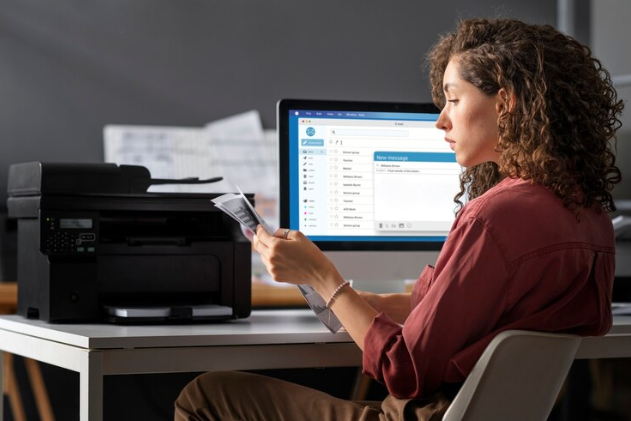In today’s fast-paced business environment, efficiency and uptime are critical to success. As companies grow and adopt more complex IT infrastructures, managing print devices has become an essential aspect of overall IT support. Remote printer management has emerged as a key solution for IT support teams looking to optimize printing operations, minimize downtime, and reduce costs. This approach not only streamlines operations but also provides the flexibility businesses need to stay competitive.
What is Remote Printer Management?
Remote printer management is a solution that allows IT support teams to monitor, manage, and troubleshoot printers from a central location, without the need to be physically present at each device. This technology relies on software tools that enable remote access to printers and their settings, allowing IT professionals to address issues, track usage, and ensure optimal performance—all without stepping foot in the office.
For businesses with multiple locations or distributed teams, remote printer management can be a game-changer. IT support teams can quickly resolve printer issues, update drivers, and deploy configurations across an entire network, reducing the need for on-site visits and improving response times.
Why Remote Printer Management Matters for IT Support Teams
- Improved Efficiency and Productivity
Businesses today rely heavily on printers to meet day-to-day operational needs. From printing contracts to invoices and reports, any interruption in printer functionality can cause significant delays. With remote printer management, IT support teams can monitor printer health in real time, identifying potential problems before they disrupt business operations. This proactive approach helps reduce downtime, ensuring employees stay productive without having to wait for technical support. - Cost Savings
Managing a fleet of printers across various departments or locations can become costly for businesses. The traditional approach often involves IT staff traveling to different sites to resolve issues or install updates. Remote management cuts down on these travel expenses by allowing IT support teams to address problems remotely, saving both time and money. Additionally, remote management software provides valuable insights into printer usage patterns, helping businesses optimize resources, reduce waste, and make more informed decisions about equipment purchases or upgrades. - Enhanced Security
Printer security is often an overlooked aspect of IT security. Yet, printers are vulnerable to cyberattacks just like any other networked device. Remote printer management solutions help address this concern by allowing IT teams to monitor and enforce security policies across all connected printers. Features such as user authentication, secure printing protocols, and data encryption can be remotely configured, ensuring that printers do not become an entry point for cyber threats. This is especially important for businesses dealing with sensitive information, such as legal or financial services, where data breaches could have severe consequences. - Centralized Monitoring and Reporting
Remote printer management platforms provide a centralized dashboard that offers real-time visibility into printer status, usage statistics, and maintenance requirements. IT support teams can quickly see which devices are functioning properly and which need attention. This centralized monitoring helps ensure that the right resources are allocated where they are most needed, and enables businesses to track printing trends and identify opportunities for cost savings. - Simplified Maintenance
Printers, like any other technology, require regular maintenance to function optimally. Remote printer management enables IT teams to remotely install updates, configure settings, and perform routine tasks like resetting counters or adjusting print parameters. If a printer runs low on toner or needs servicing, the system can automatically alert IT staff, prompting them to take action before a small issue turns into a major problem. This ability to perform maintenance tasks remotely without requiring physical intervention increases operational efficiency and reduces the risk of printer-related disruptions. - Scalability for Growing Businesses
As businesses expand, their printing needs often become more complex. Remote printer management is scalable, making it easier for IT support teams to manage printers across multiple locations or departments. New printers can be added to the network and configured remotely, reducing the time it takes to get them up and running. For businesses implementing “Business Printer Solutions” on a larger scale, this scalability ensures that their printing infrastructure can grow in tandem with the company.
Key Features of Remote Printer Management Solutions
When considering remote printer management, businesses should look for solutions that offer the following key features:
- Real-Time Monitoring: The ability to track printer performance, ink/toner levels, and paper usage in real time.
- Automatic Alerts: Notifications when printers experience issues, run low on supplies, or require maintenance.
- Remote Configuration: The ability to configure printer settings and deploy software updates remotely, reducing the need for on-site visits.
- Security Management: Tools to manage security settings, such as authentication protocols and data encryption, across all networked printers.
- Usage Analytics: Insights into printing patterns, including the volume of prints by user or department, enabling businesses to optimize their printing resources and reduce costs.
Implementing Remote Printer Management in Your Business
For businesses looking to implement remote printer management, the first step is to select the right software solution. Several vendors offer remote printer management tools that cater to businesses of all sizes. IT support teams should evaluate the features, ease of use, and scalability of these platforms to determine which one aligns best with the company’s needs.
Once the solution is in place, it is essential to train IT staff on how to use the system effectively. Familiarizing the team with the software will help them respond quickly to any printer-related issues and ensure that they can leverage the full capabilities of remote management tools.
Finally, businesses should continuously evaluate their printing needs and adjust their printer fleet or management strategies as required. This could include upgrading to more energy-efficient models, integrating additional security features, or expanding the remote management system to support new devices.
Conclusion
Incorporating remote printer management into your business IT infrastructure is a smart way to improve operational efficiency, reduce costs, and enhance security. By leveraging the power of remote management tools, IT support teams can ensure that printers are always available, secure, and running optimally. For businesses seeking comprehensive business printer solutions, remote printer management is an essential component of a modern, scalable, and cost-effective printing environment.
As businesses continue to rely on technology to streamline operations, remote printer management will play an increasingly crucial role in maintaining productivity and minimizing downtime.




